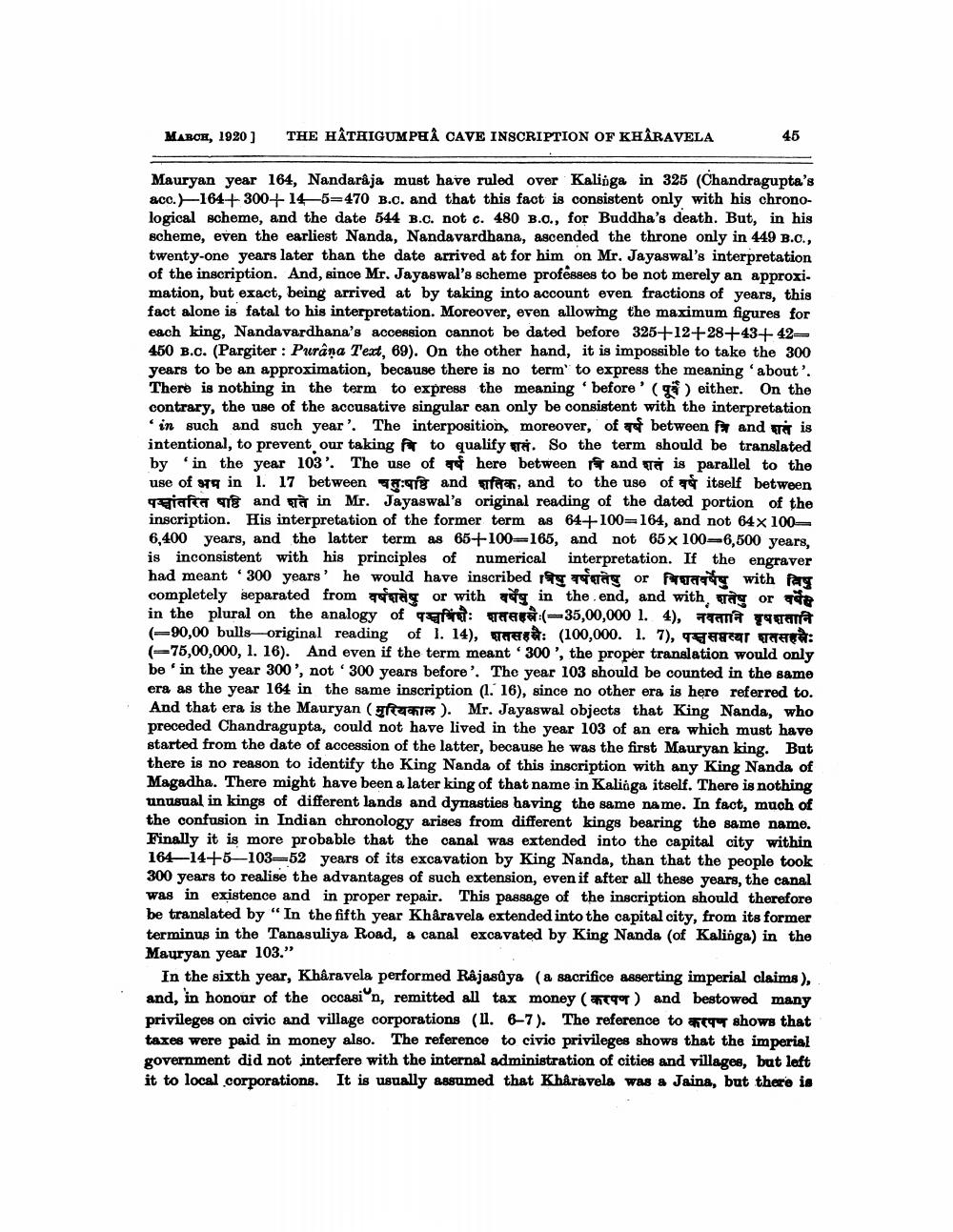________________
MARCH, 1920 ]
THE HÂTAIGUMPHẢ CAVE INSCRIPTION OF KHARAVELA
45
Mauryan year 164, Nandaraja must have ruled over Kalinga in 325 (Chandragupta's acc. 164+ 300+ 145=470 B.C. and that this fact is consistent only with his chronological scheme, and the date 544 B.C. not c. 480 B.O., for Buddha's death. But, in his scheme, even the earliest Nanda, Nandavardhana, ascended the throne only in 449 B.C., twenty-one years later than the date arrived at for him on Mr. Jayaswal's interpretation of the inscription. And, since Mr. Jayaswal's scheme professes to be not merely an approxi. mation, but exact, being arrived at by taking into account even fractions of years, this fact alone is fatal to his interpretation. Moreover, even allowing the maximum figures for each king, Nandavardhana's accession cannot be dated before 325+12+28+43+42— 450 B.C. (Pargiter : Purana Test, 69). On the other hand, it is impossible to take the 300 years to be an approximation, because there is no term to express the meaning about'. There is nothing in the term to express the meaning before' (që) either. On the contrary, the use of the accusative singular can only be consistent with the interpretation
in such and such year'. The interposition, moreover, of te between fr and is intentional, to prevent our taking it to qualify . So the term should be translated by in the year 103'. The use of here between r and is parallel to the use of 979 in 1. 17 between re and afere, and to the use of itself between
eig que and in Mr. Jayaswal's original reading of the dated portion of the inscription. His interpretation of the former term as 64+100=164, and not 64 x 100— 6,400 years, and the latter term as 65+100=165, and not 65 x 100=6,500 years. is inconsistent with his principles of numerical interpretation. If the engraver had meant "300 years' he would have inscribed T agor frau with fast completely separated from ay or with us in the end, and with an order in the plural on the analogy of refra: Tec(-35,00,000 1.4), Taa yama (-90,00 bulls original reading of l. 14), Tex: (100,000. 1. 7), F a r #: (-75,00,000, 1. 16). And even if the term meant '300', the proper translation would only be in the year 300', not .300 years before. The year 103 should be counted in the same era as the year 164 in the same inscription (1. 16), since no other era is here referred to. And that era is the Mauryan (guna ). Mr. Jayaswal objects that King Nanda, who preceded Chandragupta, could not have lived in the year 103 of an era which must have started from the date of accession of the latter, because he was the first Mauryan king. But there is no reason to identify the King Nanda of this inscription with any King Nanda of Magadha. There might have been a later king of that name in Kalinga itself. There is nothing unusual in kings of different lands and dynasties having the same name. In fact, much of the confusion in Indian chronology arises from different kings bearing the same name. Finally it is more probable that the canal was extended into the capital city within 164—14+5—103—52 years of its excavation by King Nanda, than that the people took 300 years to realise the advantages of such extension, even if after all these years, the canal was in existence and in proper repair. This passage of the inscription should therefore be translated by "In the fifth year Khåravela extended into the capital city, from its former terminus in the Tanasuliya Road, & canal excavated by King Nanda (of Kalinga) in the Mauryan year 103."
In the sixth year, Khâravela performed Rajasuya (a sacrifice asserting imperial claims ), and, in honour of the occasion, remitted all tax money (
a r) and bestowed many privileges on civic and village corporations (11.6–7). The reference to shows that taxes were paid in money also. The reference to civio privileges shows that the imperial government did not interfere with the internal administration of cities and villages, but left it to local corporations. It is usually assumed that Khåravela was a Jaina, but there is




